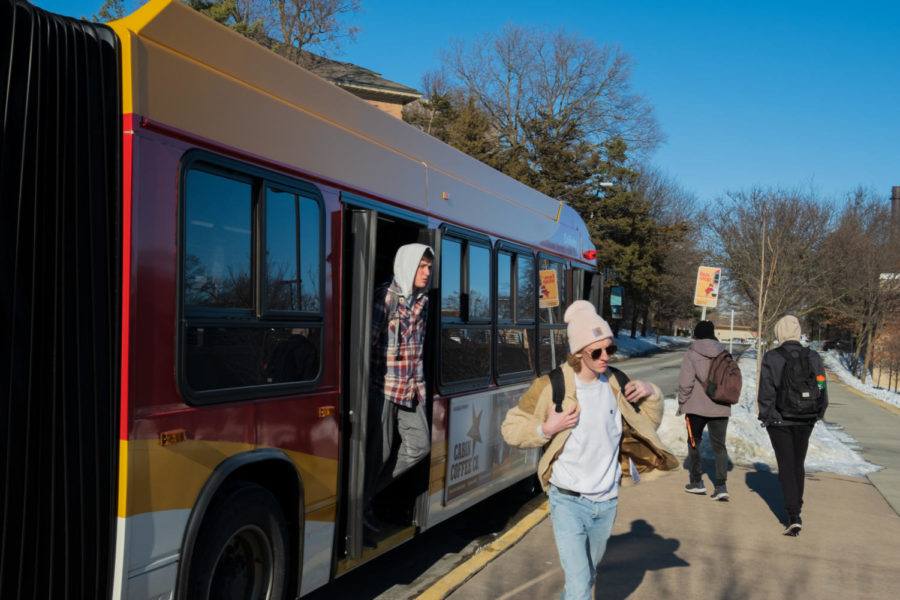Breaking down CyRide’s recent accident totals
Students transfer on and off the Orange 23 bus on Wallace Road Feb. 1.
Despite common legend, getting hit by a CyRide does not earn students free tuition. Even if it did, the chances of this happening may be different from what many expect.
CyRide has averaged 28 accidents per year since June 2019, according to data received from CyRide’s assistant director of operations, Kristine Crippen.
CyRide is the city bus system for Ames and is free for Iowa State students to ride. It operates 13 fixed routes that wind through the university’s campus and the surrounding areas of town.
The company defines an “accident” as any incident that causes a dollar amount of damage, which can include bumping a curb or brushing up against a tree branch.
CyRide has recorded 22 total accidents in the 2023 record year, which began in June 2022 and will end this summer. Each of CyRide’s record years extends from June to June.
Of these 22 accidents, five involved a fixed object on the road, such as a stop sign or deer, and eight involved another vehicle. The remaining nine took place on CyRide property.
Many of CyRide’s accidents take place on the property of their home facility when drivers park the buses in the garage or drive them out of the parking lot.
“The garage is really tight, and we keep a lot of buses inside,” Crippen said. “In the mornings when you’re pulling out, you have to be really careful as you’re turning not to hit another bus or hit your mirror on a pole.”
For vehicle to vehicle accidents, most are caused by rear-end incidents, according to Crippen. Of the eight vehicle accidents in 2023, seven were the result of another driver rear ending a CyRide.
“It sounds weird, but people don’t realize we’re stopped when we’re at a bus stop,” Crippen said, “so we get rear ended a lot.”
After each accident, Crippen reviews the circumstances to determine if the incident was preventable. A safety committee of experienced drivers also meets quarterly to go over accident reports and draw their own conclusions.
To complete these reviews, they utilize video cameras, which are placed in the interior and exterior of each bus in several locations. Due to the number of cameras located on each bus, Crippen and other viewers can determine what was happening in and around the bus before an accident took place.
“It’s easy to look at it in hindsight and say, ‘Well, you should have avoided that,” Crippen said, “so I try to count in what was going on and what that space of road’s like.”
Oftentimes, drivers can be occupied with other tasks, such as looking at pedestrians, according to Crippen.
“There’s just a lot of different factors you kind of have to take into account,” Crippen said.
When an accident does occur, CyRide will replace the involved bus with a new vehicle, depending on the level of damage. The driver involved must also go in for a random drug and alcohol test.
In some situations, the driver will be relieved of their shift early to tend to their mental wellbeing.
“It can be pretty upsetting, so if the driver needs to be relieved we’ll have somebody else go out,” Crippen said. “Sometimes it’s just so startling, especially when you’re driving and someone pulls out in front of you and you can’t get stopped.”
If an accident occurs with a full bus, another bus is sent for passengers to transfer onto. CyRide will also ask passengers to fill out information cards to help contribute to witness reports.
CyRide currently has around 130 drivers, a majority of which are part-time student drivers.
During their training, drivers are taught to pay attention to what is happening near the bus and to be defensive to their surroundings. They typically rack up around 120 hours of driving time before officially hitting the road as a driver.
“[Training] is pretty in depth,” Crippen said. “By the time we train you, you’re probably actually a safer driver.”
Jack Schlabaugh, a junior studying agricultural systems technology, feels “super safe” while on the bus, which he rides every day. He credits this to the training he witnessed when he applied to be a driver in the past. Schlabaugh did not get hired but appreciated the staff’s training efforts.
“Everyone I talked to there made sure everyone was being safe, following instructions and doing all the training they needed to,” Schlabaugh said.
Cole Langner, a senior studying software engineering, rides the CyRide one to two times a month. He and his friends love to joke about getting hit by a CyRide for free tuition, but he feels it would be highly unlikely to happen.
“I feel like the drivers get good enough training for that, and they drive enough on campus where they know students don’t really look while they’re walking,” Langner said.
The full breakdown of CyRide accident totals from June 2019 to now:
June 2022-January 2023
On property: 9 accidents
Off property: 13 accidents
(Fixed objects: 5) (Other vehicles: 8)June 2021-2022
On property: 8 accidents
Off property: 29 accidents
(Fixed objects: 15) (Other vehicles: 14)June 2020-2021
On property: 6 accidents
Off property: 20 accidents
(Fixed objects: 12) (Other vehicles: 8)June 2019-2020
On property: 10 accidents
Off property: 26 accidents
(Fixed objects: 9) (Other vehicles: 17)
Your donation will support the student journalists of the Iowa State Daily. Your contribution will allow us to purchase equipment, send our student journalists to conferences and off-set their cost of living so they can continue to do best-in-the-nation work at the Iowa State Daily.










